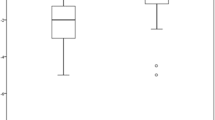Summary
AIM: Comparison of the postoperative results after the implantation of two different aspherical intraocular lenses (IOL), a toric IOL and a non-toric IOL. PATIENTS AND METHODS: In this study, patients with cataract senilis were treated with an implantation of an aspherical IOL. Therefore two groups of 25 operated eyes each were compared. One group was implanted the AcrySof®-IQ-IOL (SN60WF), the other group the AcrySof®-Toric-IOL (SN60T3, SN60T4 or SN60T5). The pre- and postoperative visual acuity was compared by taking measurements of the sphere, the cylinder and the best corrected visual acuity (BCVA). RESULTS: It turned out that there is a significant difference (p ≤ 0,05) between the pre- and postoperative results in the AcrySof®-IQ- and AcrySof®-Toric-group. Especially the results of the cylinder and the BVCA showed a significant difference in both groups. The cylinder of the AcrySof®-Toric-group was even more significant (p ≤ 0,01 at all three measuring procedures) than the one of the AcrySof®-IQ-group (p > 0,05 one day, p = 0,01 one week and p < 0,05 two months postoperative). The results from the BCVA were less significant in the AcrySof®-Toric-group (p < 0,05) than in the AcrySof®-IQ-group (p < 0,01). The spherical power showed a significant difference (p < 0,05) in the AcrySof®-IQ-group only one week postoperatively but not at any time in the AcrySof®-Toric-group. Concerning the spherical equivalent (SE) there was only a significant difference detected in the group of the AcrySof®-Toric-IOL (p < 0,05 at all measuring procedures). CONCLUSION: The AcrySof®-Toric-IOL showed a more significant improvement regarding the cylinder and the spherical equivalent than the AcrySof®-IQ-IOL.
Zusammenfassung
ZIEL: Vergleich der postoperativen Ergebnisse nach Implantation von zwei verschiedenen asphärischen Intraokularlinsen (IOL), einer torischen und einer nicht-torischen. PATIENTINNEN UND METHODEN: In dieser Studie wurden PatientInnen mit einer Cataracta senilis durch Implantation einer asphärischen Intraokularlinse behandelt. Zu vergleichen waren hierbei zwei gleich große Gruppen aus jeweils 25 operierten Augen, bei denen entweder die nicht-torische AcrySof®-IQ-IOL (SN60WF) oder die torische AcrySof®-Toric-IOL (SN60T3, SN60T4 oder SN60T5) implantiert wurde. Die prä- und postoperative Sehleistung wurde durch Messungen von Sphäre, Zylinder und Visus cum correctione (V.c.c) verglichen. Die postoperativen Messungen fanden einen Tag, eine Woche und zwei Monate nach der Implantation statt. RESULTATE: Die Auswertung ergab signifikante Unterschiede (p ≤ 0,05), wenn man jede IOL für sich betrachtet, und innerhalb der einzelnen Gruppen die post- zu präoperativen Werte miteinander vergleicht. So haben sich vor allem die Zylinderwerte und der V.c.c. in beiden Vergleichsgruppen signifikant verändert. Die Zylinderwerte der AcrySof®-Toric-Gruppe zeigten eine höhere Signifikanz (p ≤ 0,01 zu allen drei Messzeitpunkten) als die der AcrySof®-IQ-Gruppe (p > 0,05 einen Tag postoperativ, p = 0,01 eine Woche und p < 0,05 zwei Monate postoperativ). Die Ergebnisse des V.c.c. der AcrySof®-Toric-Gruppe waren weniger signifikant (p < 0,05 zu allen drei Zeitpunkten) wie die der AcrySof®-IQ-Gruppe (p ≤ 0,01 zu allen drei Zeitpunkten). Die Werte der Sphäre ergaben nur eine Woche postoperativ in der Gruppe der AcrySof®-IQ-IOL einen signifikanten Unterschied (p < 0,05). Hingegen war das sphärische Äquivalent in der AcrySof®-Toric-Gruppe zu allen Messzeiten (p < 0,05) besser als in der AcrySof®-IQ-Gruppe (p > 0,1). SCHLUSSFOLGERUNG: Die in dieser Studie untersuchte AcrySof®-Toric-IOL zeigte bezüglich Zylinder und sphärischem Äquivalent signifikantere Verbesserungen als die AcrySof®-IQ-IOL.
Similar content being viewed by others
Literatur
Thylefors B (1990) The World Health Organization's programme for the prevention of blindness. Int Ophthalmol 14 (3): 211–219
Sun XY, Vicary D, Montgomery P, Griffiths M (2000) Toric intraocular lenses for correcting astigmatism in 130 eyes. Ophthalmology 107 (9): 1776–1781; discussion 81–82
Viestenz A (2004) Torische Kunstlinse zur Korrektur eines persistierenden kornealen Astigmatismus nach perforierender Keratoplastik. Ophthalmologe 102 (20. Aug. 2005): 147–152
Till JS, Yoder PR, Jr, Wilcox TK, Spielman JL (2002) Toric intraocular lens implantation: 100 consecutive cases. J Cataract Refract Surg 28 (2): 295–2301
Bauer NJ, de Vries NE, Webers CA, Hendrikse F, Nuijts RM (2008) Astigmatism management in cataract surgery with the AcrySof toric intraocular lens. J Cataract Refract Surg 34 (9): 1483–1488
Mendicute J, Irigoyen C, Aramberri J, Ondarra A, Montes-Mico R (2008) Foldable toric intraocular lens for astigmatism correction in cataract patients. J Cataract Refract Surg 34 (4): 601–607
Gerten G, Michels A, Olmes A (2001) Toric intraocular lenses. Clinical results and rotational stability. Ophthalmologe 98 (8): 715–720
Rushworm I (2000) Astigmatism correction with a foldable toric IOL. J Cataract Refract Surg 26: 1023–1027
Author information
Authors and Affiliations
Corresponding author
Rights and permissions
About this article
Cite this article
Sprenger, F., Kieselbach, G. Astigmatismusverlauf nach Implantation asphärischer Intraokularlinsen. Spektrum Augenheilkd. 24, 230–233 (2010). https://doi.org/10.1007/s00717-010-0420-z
Issue Date:
DOI: https://doi.org/10.1007/s00717-010-0420-z




